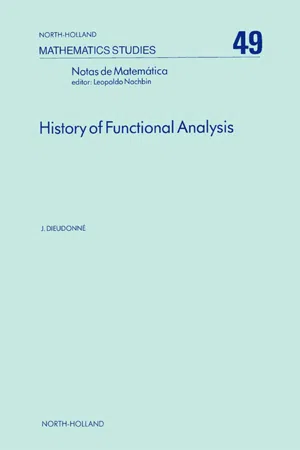
History of Functional Analysis
J. Dieudonne
- 311 pagine
- English
- ePUB (disponibile sull'app)
- Disponibile su iOS e Android
History of Functional Analysis
J. Dieudonne
Informazioni sul libro
History of Functional Analysis presents functional analysis as a rather complex blend of algebra and topology, with its evolution influenced by the development of these two branches of mathematics. The book adopts a narrower definition—one that is assumed to satisfy various algebraic and topological conditions. A moment of reflections shows that this already covers a large part of modern analysis, in particular, the theory of partial differential equations. This volume comprises nine chapters, the first of which focuses on linear differential equations and the Sturm-Liouville problem. The succeeding chapters go on to discuss the ""crypto-integral"" equations, including the Dirichlet principle and the Beer-Neumann method; the equation of vibrating membranes, including the contributions of Poincare and H.A. Schwarz's 1885 paper; and the idea of infinite dimension. Other chapters cover the crucial years and the definition of Hilbert space, including Fredholm's discovery and the contributions of Hilbert; duality and the definition of normed spaces, including the Hahn-Banach theorem and the method of the gliding hump and Baire category; spectral theory after 1900, including the theories and works of F. Riesz, Hilbert, von Neumann, Weyl, and Carleman; locally convex spaces and the theory of distributions; and applications of functional analysis to differential and partial differential equations. This book will be of interest to practitioners in the fields of mathematics and statistics.
Domande frequenti
Informazioni
Linear Differential Equations and the Sturm-Liouville Problem
§1 Differential Equations and Partial Differential Equations in the XVIIIth Century

















Indice dei contenuti
- Cover image
- Title page
- Table of Contents
- Copyright page
- Introduction
- Chapter I: Linear Differential Equations and the Sturm-Liouville Problem
- Chapter II: The “Crypto-Integral” Equations
- Chapter III: The Equation Of Vibrating Membranes
- Chapter IV: The Idea Of Infinite Dimension
- Chapter V: The Crucial Years and the Definition of Hilbert Space
- Chapter VI: Duality and the Definition of Normed Spaces
- Chapter VII: Spectral Theory After 1900
- Chapter VIII: Locally Convex Spaces and the Theory of Distributions
- Chapter IX: Applications of Functional Analysis to Differential and Partial Differential Equations
- References
- Author Index
- Subject Index